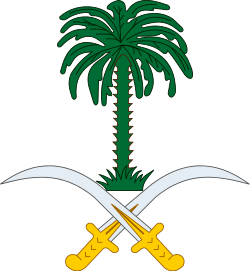Kingdom of Hejaz and Nejd
| Kingdom of Hejaz and Nejd | ||||||
| مملكة الحجاز ونجد Mamlakat al-Ḥijāz wa-Najd | ||||||
| Political union of Nejd and Hejaz | ||||||
| ||||||
| ||||||
| Capital | Riyadh | |||||
| Languages | Arabic Ottoman Turkish | |||||
| Religion | Islam | |||||
| Government | Absolute monarchy | |||||
| King | Abdul Aziz ibn Saud | |||||
| Viceroy | Faisal (Hejaz) | |||||
| Saud (Nejd) | ||||||
| Historical era | Interwar period | |||||
| - | Ibn Saud crowned King of Hejaz | 8 January 1926 | ||||
| - | Nejd decreed a kingdom | 29 January 1927 | ||||
| - | Saudi Arabia established | 23 September 1932 | ||||
| Area | ||||||
| - | 1932 | 2,149,690 km² (830,000 sq mi) | ||||
| Population | ||||||
| - | 1932 est. | 2,439,000 | ||||
| Density | 1.1 /km² (2.9 /sq mi) | |||||
Part of a series on the |
|---|
| History of Saudi Arabia |
 |
| Saudi Arabia portal |
The Kingdom of Hejaz and Nejd (Arabic: مملكة الحجاز ونجد, Mamlakat al-Ḥijāz wa-Najd) was a political union established after the Kingdom of Hejaz had been conquered by the Sultanate of Nejd under Abdul Aziz Ibn Saud in 1925.
History
On 8 January 1926, Ibn Saud, the Sultan of Nejd, was crowned King of the Hejaz in the Masjid al-Haram in Makkah, and he elevated Nejd to the status of a kingdom on 27 January 1927.[1] At the Treaty of Jeddah on 20 May 1927, Ibn Saud's realm was recognised by the United Kingdom of Great Britain and Northern Ireland, and was addressed as the Kingdom of Hejaz and Nejd.
For the next five years, Ibn Saud administered the two parts of his dual kingdom as separate units. On 23 September 1932, the main Saudi dominions of Al-Hasa, Qatif, Nejd and the Hejaz were unified as the Kingdom of Saudi Arabia.
Foreign policy
The Kingdom of Hejaz and Nejd could pursue its expansionist policy by British arms supplies because of its close relations with the United Kingdom. Under Ibn Saud, the Hejaz withdrew from the League of Nations.
In 1926, the Kingdom of Hejaz and Nejd was recognised by the Union of Soviet Socialist Republics, followed by the United States of America in 1931. By 1932, the United Kingdom, the USSR, Turkey, the Imperial State of Iran and The Netherlands maintained legations in Jeddah; The French Third Republic, the Kingdom of Italy and the Kingdom of Egypt maintained unofficial consular representatives.
Flags of Nejd and Hejaz
-
.svg.png)
Flag of Nejd
(1926 – Sep 1932) -

Flag of Hejaz
(18 Jan 1926 – 22 Sep 1932)
Notes
- ↑ Joseph Kostiner, The Making of Saudi Arabia, 1916–1936: From Chieftaincy to Monarchical State (Oxford University Press US, 1993), ISBN 0-19-507440-8, p104
Sources
| ||||||||||||